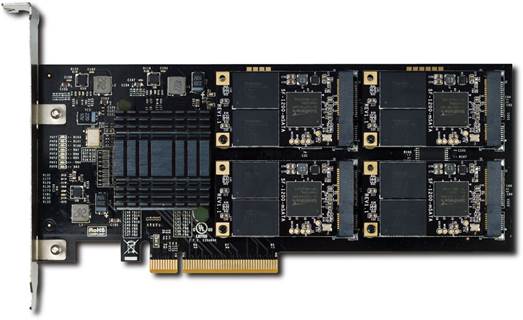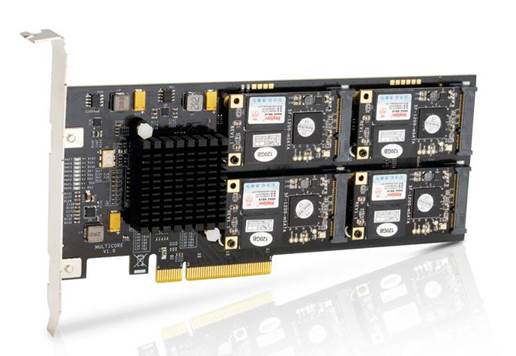Vital statistics
·
Price: $1,720
·
Manufacturer: KingSpec
·
Web: www.kingspec.com
·
Capacity: 1TB
·
Memory type: MLC synchronous
·
Controller: 8x SandForce SF-1200
·
Interface: PCI-Express 8-lane
·
Peak performance: 2GB/sread, 2GB/s write
·
Max lOPS: 130k

Exotic sports cars ain't what they used to
be. Hurl a gold Rolex over your shoulder almost anywhere in West London today,
and odds are you'll take out a Ferrari, Lamborghini or perhaps a Pagani.
You could say the same about PC components.
The frisson of the truly unusual has been dampened by broader adoption of high
performance kit and a narrowing of the performance delta between mid-range and
the top-rung kit.
But a 1TB solid state drive sporting a
superfast PCI Express interface, whole gigabytes per-second of bandwidth and a
$1,600 price tag? That's got to qualify.
It's the McLaren PI of PC components with
specs that are simply out of this world.
However, unlike hypercars, the KingSpec
PCIe SSD can justify its existence in purely practical terms. The fact is, the
SATA interface is proving to be an increasing bottleneck when it comes to peak
data transfer rates with the latest SSDs.
The solution is to dip into the huge
bandwidth of multi-lane PCI Express, an interface designed to feed the epic
bandwidth needs of modern graphics chips. Sounds like a good idea to us. The
specifics begin with an eight-lane physical card in PCI Express 2.0
configuration, giving a theoretical total of 4GB/s of raw bandwidth.
With that, the tables are turned. It's now
the SSD hardware - the memory chips and controller - that are under pressure to
deliver. Kingspec's answer involves no fewer than eight 120GB mSATA SSDs, each
with its own last-gen SF controller. Suddenly, that price tag doesn't look so
bad.
Hook them altogether, stir in some RAID
striping sauce and you have a recipe for epic performance. It varies according
to model (there's a 500GB or 2TB), but this 1TB effort is rated at 2GB/s for
both reads and writes. Yikes.
This is no chintzy lash up, either. It's just
a case of bringing together well-established technologies, including PCI
Express, RAID and SandForce based SSDs to overcome the limitations of the SATA
interface.
Crashing to earth
Unfortunately, the real-world results don’t
stack up. You can extract peak transfer rates in line with the 2GB/s claims in
synthetic tests of peak sequential bandwidth, but both synthetic random access
and applications performance are a lot more patchy.

KingSpec
PCIe MultiCore 1TB
In terms of 4k random access, you're
looking at performance no better than a single SandForce spec SSD hooked in via
SATA. And that means slower performance than several of the latest drives,
including the Samsung drives and OCZ's Vertex 4.
However, the deal-breaker is application
performance. In both our game install test and the ZIP decompression test,
there's only one word to describe the performance of this mighty PCIe card.
Slow.
In fact, even when you might expect it to
be at its best, it's not that much quicker than the competition. Try copying
large files internally and you'll get a sustained rate of around 550MB/s. That
compares with up to 450MB/s for the best SATA drives. Put it all together and
it's clear that those seeking lTB of solid-state storage would be better off
using RAID with a pair of 500GB SSDs.
Kingston HyperX 3K 120GB
Vital statistics
·
Price: $124.8
·
Manufacturer: Kingston
·
Web: www.kingston.com
·
Capacity: 120GB
·
Memory type: MLC synchronous
·
Controller: SandForce SF-2281
·
Interface: SATA 6Gbps
·
Peak performance: 555MB/sread, 519MB/s write
·
Max IOPS: 85k

Kingston
HyperX 3K 120GB
Do we spend too much time banging on about
controller chipsets and not enough thinking about the other work that goes into
a good solid-state drive? Line up Kingston's HyperX 3K against the other
SandForce based drives here, and that seems a possibility.
After all, the HyperX sports precisely the
same SandForce SF2281 controller chip as the Intel 330 and KingSpec E3000
drives. But they're a world apart by some metrics. As we'll see, this Kingston
drive proves there's a little life left in ye olde SF-2281.
But first, let's have a quick look at the specs.
The HyperX 3K is the slightly more aggressively priced of Kingston's HyperX SSD
pairing. This is achieved by using cheaper flash memory. In this case we're
talking NAND that supports fewer write-erase cycles.
That sounds like the result will be a less
reliable drive and, in extremis, that will certainly be the case. You probably
wouldn't want to stick this drive in a mission critical server, but for home
users, the cost-benefit is a bit different.
More to the point, SSD reliability is an
issue of more than write erase robustness. Write amplification is a major
issue, too. The upshot of all this is that Kingston covers the 3K with a
three-year warranty, which is good, but not great.
Like other SandForce drives, a little of
the flash memory is soaked up for spare capacity to deliver that longevity, so
the HyperX weighs in at 120GB where some drives give you 128GB. Not a massive
problem, but all part of making that buying decision.
What really makes the HyperX stand out
against the other SandForce drives is its 4k random write performance.
Surprisingly, it scores 72.5MB/s, which makes itthe fastest drive here. Not at
all what we were expecting.
A mixed bag
The snag is that performance drops off
pretty precipitously with heavy usage. Following a few fill-and-delete cycles,
the HyperX is reduced to 59.23MB/s. That's still better than the widely lauded
Samsung 840 Pro can manage, and equal or better than most SandForce drives can
manage in box-fresh condition.

Kingston
HyperX 3K 120GB
But it's well behind the OCZ Vertex 4. The
HyperX's performance in AS SSD's incompressible sequential write benchmark is
rather under whelming too, even if it's predictable enough for a 120GB
SandForce-based drive. But the deal breaker involves the game installation and
file decompression application test results. At 52 seconds and 57 seconds
respectively, the HyperX needs roughly twice as long to complete those
benchmarks as the fastest drives here. In fact, it performs about the same as a
Crucial C300 we've been hammering in a test rig for the last two years. Not
good.
These are very confusing results, to be
sure. There's nothing in the synthetic test results that even hints at a
performance problem. We may have simply been unlucky with our sample drive. And
the likely worse-case scenario is a glitch that a firmware update would solve.
In the meantime, it's pretty hard to give the HyperX 3K a buy recommendation
when there are drives out there you can buy with confidence that they'll
deliver in the real world.